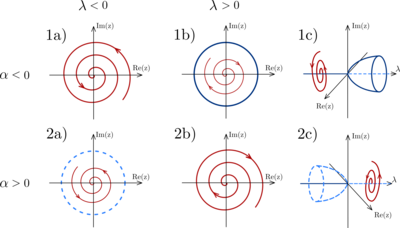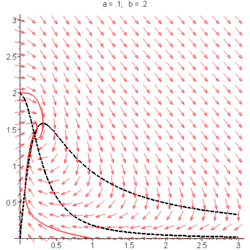Hopf bifurcation
In the mathematical theory of bifurcations, a Hopf bifurcation is a critical point where a system's stability switches and a periodic solution arises.[1] More accurately, it is a local bifurcation in which a fixed point of a dynamical system loses stability, as a pair of complex conjugate eigenvalues—of the linearization around the fixed point—crosses the complex plane imaginary axis. Under reasonably generic assumptions about the dynamical system, a small-amplitude limit cycle branches from the fixed point.

A Hopf bifurcation is also known as a Poincaré–Andronov–Hopf bifurcation, named after Henri Poincaré, Aleksandr Andronov and Eberhard Hopf.
Overview
Supercritical and subcritical Hopf bifurcations

The limit cycle is orbitally stable if a specific quantity called the first Lyapunov coefficient is negative, and the bifurcation is supercritical. Otherwise it is unstable and the bifurcation is subcritical.
The normal form of a Hopf bifurcation is:
- where z, b are both complex and λ is a parameter.
Write: The number α is called the first Lyapunov coefficient.
- If α is negative then there is a stable limit cycle for λ > 0:
- where
- The bifurcation is then called supercritical.
- If α is positive then there is an unstable limit cycle for λ < 0. The bifurcation is called subcritical.
Example

Hopf bifurcations occur in the Lotka–Volterra model of predator–prey interaction (known as paradox of enrichment), the Hodgkin–Huxley model for nerve membrane,[2] the Selkov model of glycolysis,[3] the Belousov–Zhabotinsky reaction, the Lorenz attractor, and the Brusselator.
The Selkov model is
The phase portrait illustrating the Hopf bifurcation in the Selkov model is shown on the right.[4]
In railway vehicle systems, Hopf bifurcation analysis is notably important. Conventionally a railway vehicle's stable motion at low speeds crosses over to unstable at high speeds. One aim of the nonlinear analysis of these systems is to perform an analytical investigation of bifurcation, nonlinear lateral stability and hunting behavior of rail vehicles on a tangent track, which uses the Bogoliubov method.[5]
Definition of a Hopf bifurcation
The appearance or the disappearance of a periodic orbit through a local change in the stability properties of a fixed point is known as the Hopf bifurcation. The following theorem works for fixed points with one pair of conjugate nonzero purely imaginary eigenvalues. It tells the conditions under which this bifurcation phenomenon occurs.
Theorem (see section 11.2 of [6]). Let be the Jacobian of a continuous parametric dynamical system evaluated at a steady point . Suppose that all eigenvalues of have negative real part except one conjugate nonzero purely imaginary pair . A Hopf bifurcation arises when these two eigenvalues cross the imaginary axis because of a variation of the system parameters.
Routh–Hurwitz criterion
Routh–Hurwitz criterion (section I.13 of [7]) gives necessary conditions so that a Hopf bifurcation occurs. Let us see how one can use concretely this idea.[8]
Sturm series
Let be Sturm series associated to a characteristic polynomial . They can be written in the form:
The coefficients for in correspond to what is called Hurwitz determinants.[8] Their definition is related to the associated Hurwitz matrix.
Propositions
Proposition 1. If all the Hurwitz determinants are positive, apart perhaps then the associated Jacobian has no pure imaginary eigenvalues.
Proposition 2. If all Hurwitz determinants (for all in are positive, and then all the eigenvalues of the associated Jacobian have negative real parts except a purely imaginary conjugate pair.
The conditions that we are looking for so that a Hopf bifurcation occurs (see theorem above) for a parametric continuous dynamical system are given by this last proposition.
Example
Consider the classical Van der Pol oscillator written with ordinary differential equations:
The Jacobian matrix associated to this system follows:
The characteristic polynomial (in ) of the linearization at (0,0) is equal to:
The coefficients are:
The associated Sturm series is:
The Sturm polynomials can be written as (here ):
The above proposition 2 tells that one must have:
Because 1 > 0 and −1 < 0 are obvious, one can conclude that a Hopf bifurcation may occur for Van der Pol oscillator if .
See also
- Reaction–diffusion systems
References
- "Hopf Bifurcations" (PDF). MIT.
- Guckenheimer, J.; Labouriau, J.S. (1993), "Bifurcation of the Hodgkin and Huxley equations: A new twist", Bulletin of Mathematical Biology, 55 (5): 937–952, doi:10.1007/BF02460693.
- "Selkov Model Wolfram Demo". [demonstrations.wolfram.com ]. Retrieved 30 September 2012.
- For detailed derivation, see Strogatz, Steven H. (1994). Nonlinear Dynamics and Chaos. Addison Wesley. p. 205. ISBN 978-0-7382-0453-6.
- Serajian, Reza (2011). "Effects of the bogie and body inertia on the nonlinear wheel-set hunting recognized by the hopf bifurcation theory" (PDF). International Journal of Automotive Engineering. 3 (4): 186–196.
- Hale, J.; Koçak, H. (1991). Dynamics and Bifurcations. Texts in Applied Mathematics. 3. Berlin: Springer-Verlag. ISBN 978-3-540-97141-2.
- Hairer, E.; Norsett, S. P.; Wanner, G. (1993). Solving Ordinary Differential Equations I: Nonstiff Problems (Second ed.). New York: Springer-Verlag. ISBN 978-3-540-56670-0.
- Kahoui, M. E.; Weber, A. (2000). "Deciding Hopf bifurcations by quantifier elimination in a software component architecture". Journal of Symbolic Computation. 30 (2): 161–179. doi:10.1006/jsco.1999.0353.
Further reading
- Strogatz, Steven H. (1994). Nonlinear Dynamics and Chaos. Addison Wesley. ISBN 978-0-7382-0453-6.
- Kuznetsov, Yuri A. (2004). Elements of Applied Bifurcation Theory (Third ed.). New York: Springer-Verlag. ISBN 978-0-387-21906-6.
- Hale, J.; Koçak, H. (1991). Dynamics and Bifurcations. Texts in Applied Mathematics. 3. Berlin: Springer-Verlag. ISBN 978-3-540-97141-2.
- Guckenheimer, J.; Myers, M.; Sturmfels, B. (1997). "Computing Hopf Bifurcations I". SIAM Journal on Numerical Analysis. 34 (1): 1–21. CiteSeerX 10.1.1.52.1609. doi:10.1137/S0036142993253461.
External links
| Wikimedia Commons has media related to Hopf bifurcations. |